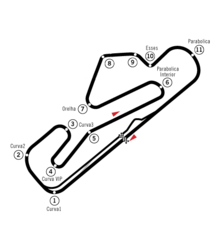1992 Portuguese Grand Prix
| Race details | |||
|---|---|---|---|
| Race 14 of 16 in the 1992 Formula One season | |||
 |
|||
| Date | 27 September 1992 | ||
| Official name | XXI Grande Premio de Portugal | ||
| Location | Autódromo do Estoril, Estoril, Portugal | ||
| Course | Permanent racing facility | ||
| Course length | 4.349 km (2.703 mi) | ||
| Distance | 71 laps, 308.779 km (191.913 mi) | ||
| Weather | Dry, sunny, windy | ||
| Pole position | |||
| Driver | Williams-Renault | ||
| Time | 1:13.041 | ||
| Fastest lap | |||
| Driver |
|
McLaren-Honda | |
| Time | 1:16.272 on lap 66 | ||
| Podium | |||
| First | Williams-Renault | ||
| Second | McLaren-Honda | ||
| Third | McLaren-Honda | ||
The 1992 Portuguese Grand Prix was a Formula One motor race held at Autódromo do Estoril on 27 September 1992. It was the fourteenth round of the 1992 Formula One season.
Nigel Mansell won the race from pole position, in the process setting new records for most wins (nine) and most points (108) in one season, with McLaren drivers Gerhard Berger and Ayrton Senna second and third. However, the race is best remembered for the accident between Berger and Mansell's Williams team-mate Riccardo Patrese. Intending to make a pit stop, Berger moved towards the right side of the track at the beginning of the start/finish straight, with Patrese following in his slipstream. Failing to realise Berger's intentions, Patrese swerved to avoid him, but his right front wheel hit Berger's left rear and the Williams was launched into the air, almost hitting a pedestrian bridge over the track. Patrese escaped the accident shaken but unhurt, and neither driver was punished by the stewards. The debris from the crash, however, caused numerous other incidents, with Michael Schumacher and Pierluigi Martini suffering punctures, and JJ Lehto suffering slight injury as the driveshaft of the Williams went through the undertray of his Dallara, hitting him on the leg.
Before this race, the financially troubled Fondmetal team pulled out of the sport, the third team to do so this season after Brabham and Andrea Moda. That meant that there were only 26 cars on the entry list, and hence this Grand Prix was the first since 1987 in which all cars automatically qualified for the race, regardless of qualifying lap times.
This race was the last time a Honda-powered car set the fastest lap until Fernando Alonso repeated the achievement in the 2016 Italian Grand Prix.
...
Wikipedia
